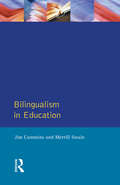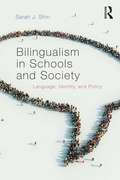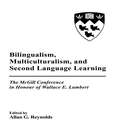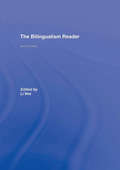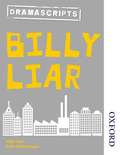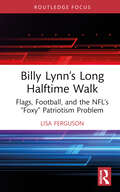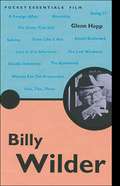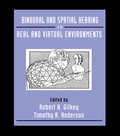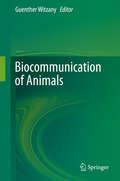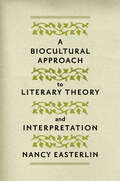- Table View
- List View
Bilingualism in Education: Aspects of theory, research and practice
by Jim Cummins Merrill SwainThis is a remarkably interesting and useful book...it makes a significant contribution to our knowledge and understanding of both bilingualism and education.'Journal of Education Policy
Bilingualism in Education: Aspects of theory, research and practice
by Jim Cummins Merrill SwainThis is a remarkably interesting and useful book...it makes a significant contribution to our knowledge and understanding of both bilingualism and education.'Journal of Education Policy
Bilingualism in Schools and Society: Language, Identity, and Policy
by Sarah J. ShinThis book is an introduction to the social and educational aspects of bilingualism. It presents an overview of a broad range of sociolinguistic and political issues surrounding the use of two languages, including code-switching in popular music, advertising, and online social spaces. It offers a well-informed discussion of what it means to study and live with multiple languages in a globalized world and practical advice on raising bilingual children.
Bilingualism in Schools and Society: Language, Identity, and Policy
by Sarah J. ShinThis book is an introduction to the social and educational aspects of bilingualism. It presents an overview of a broad range of sociolinguistic and political issues surrounding the use of two languages, including code-switching in popular music, advertising, and online social spaces. It offers a well-informed discussion of what it means to study and live with multiple languages in a globalized world and practical advice on raising bilingual children.
Bilingualism in Schools and Society: Language, Identity, and Policy, Second Edition
by Sarah J. ShinThis revised edition of Bilingualism in Schools and Society is an accessible introduction to the sociolinguistic and educational aspects of and the political issues surrounding bilingualism, including code-switching in popular music, advertising, and online social spaces. It also addresses the personal aspect of the topic in a well-informed discussion of what it means to study and live with multiple languages in a globalized world and practical advice on raising bilingual children. Extensive new material has been added that deals with more holistic understandings of bilingual performance, including translanguaging, flexible bilingualism, and code-meshing; blending standard and vernacular languages/dialects in hybrid texts; and recent developments in policies surrounding the education of English Learners and EL assessment, including Common Core State Standards (CCSS), PARCC and SBAC testing, WIDA and ELPA21 language assessments, and Every Student Succeeds Act (ESSA). Updated and new discussions on community-based heritage language programs and 'super-diversity' further enhance this new edition, along with updated statistics on bilingual populations and the world's top languages. Each chapter includes lists of further readings, helpful digital resources and study questions, as well as student activities and boxed vignettes. Firmly grounded in the analysis of empirical work with bilingual children and adults in various multilingual settings throughout the world, Bilingualism in Schools and Society is the ideal text for courses on bilingualism in language education programs.
Bilingualism in Schools and Society: Language, Identity, and Policy, Second Edition
by Sarah J. ShinThis revised edition of Bilingualism in Schools and Society is an accessible introduction to the sociolinguistic and educational aspects of and the political issues surrounding bilingualism, including code-switching in popular music, advertising, and online social spaces. It also addresses the personal aspect of the topic in a well-informed discussion of what it means to study and live with multiple languages in a globalized world and practical advice on raising bilingual children. Extensive new material has been added that deals with more holistic understandings of bilingual performance, including translanguaging, flexible bilingualism, and code-meshing; blending standard and vernacular languages/dialects in hybrid texts; and recent developments in policies surrounding the education of English Learners and EL assessment, including Common Core State Standards (CCSS), PARCC and SBAC testing, WIDA and ELPA21 language assessments, and Every Student Succeeds Act (ESSA). Updated and new discussions on community-based heritage language programs and 'super-diversity' further enhance this new edition, along with updated statistics on bilingual populations and the world's top languages. Each chapter includes lists of further readings, helpful digital resources and study questions, as well as student activities and boxed vignettes. Firmly grounded in the analysis of empirical work with bilingual children and adults in various multilingual settings throughout the world, Bilingualism in Schools and Society is the ideal text for courses on bilingualism in language education programs.
Bilingualism, Multiculturalism, and Second Language Learning: The Mcgill Conference in Honour of Wallace E. Lambert
by Allan G. ReynoldsThis collection pays tribute to Professor Wallace E. Lambert and his contributions to the fields of language and linguistics. Each chapter, written by an internationally renowned theorist or researcher, traces the currents of theory and research within the topic area to the present day, provides a state-of-the-art review of the topic, and offers an outline for future research directions. The book concludes with an overview from Professor Lambert that critically examines the impact of the ideas in each individual chapter. This volume is organized around the three areas where Professor Lambert's unique contributions are most substantial and most evident: bilingualism, multiculturalism, and second language learning. Specifically, the papers presented discuss the topics of social, psychological, cognitive, and neuropsychological aspects of bilingualism and second language learning, the psychology of inter-group relations and multiculturalism, bilingual/immersion education, and language planning. Note: Royalties earned from sales of this book will go to the Wallace E. Lambert Student Research Fund at McGill University for use by students interested in second language acquisition, bilingualism, and/or multiculturalism.
Bilingualism, Multiculturalism, and Second Language Learning: The Mcgill Conference in Honour of Wallace E. Lambert
by Allan G. ReynoldsThis collection pays tribute to Professor Wallace E. Lambert and his contributions to the fields of language and linguistics. Each chapter, written by an internationally renowned theorist or researcher, traces the currents of theory and research within the topic area to the present day, provides a state-of-the-art review of the topic, and offers an outline for future research directions. The book concludes with an overview from Professor Lambert that critically examines the impact of the ideas in each individual chapter. This volume is organized around the three areas where Professor Lambert's unique contributions are most substantial and most evident: bilingualism, multiculturalism, and second language learning. Specifically, the papers presented discuss the topics of social, psychological, cognitive, and neuropsychological aspects of bilingualism and second language learning, the psychology of inter-group relations and multiculturalism, bilingual/immersion education, and language planning. Note: Royalties earned from sales of this book will go to the Wallace E. Lambert Student Research Fund at McGill University for use by students interested in second language acquisition, bilingualism, and/or multiculturalism.
The Bilingualism Reader
by Li WeiThe Bilingualism Reader is the definitive reader for the study of bilingualism. Designed as an integrated and structured student resource it provides invaluable editorial material that guides the reader through different sections and covers:definitions and typology of bilingualism language choice and bilingual interaction bilingualism, identity and ideology grammar of code-switching and bilingual acquisition bilingual production and perception the bilingual brain methodological issues in the study of bilingualism. The second edition of this best selling volume includes nine new chapters and postscripts written by the authors of the original articles, who evaluate them in the light of recent research. Critical discussion of research methods, revised graded study questions and activities, a comprehensive glossary, and an up-to-date resource list make The Bilingualism Reader an essential introductory text for students of linguistics, psychology and education.
The Bilingualism Reader
by Li WeiThe Bilingualism Reader is the definitive reader for the study of bilingualism. Designed as an integrated and structured student resource it provides invaluable editorial material that guides the reader through different sections and covers:definitions and typology of bilingualism language choice and bilingual interaction bilingualism, identity and ideology grammar of code-switching and bilingual acquisition bilingual production and perception the bilingual brain methodological issues in the study of bilingualism. The second edition of this best selling volume includes nine new chapters and postscripts written by the authors of the original articles, who evaluate them in the light of recent research. Critical discussion of research methods, revised graded study questions and activities, a comprehensive glossary, and an up-to-date resource list make The Bilingualism Reader an essential introductory text for students of linguistics, psychology and education.
The Bilingualism Reader (PDF)
by Li WeiThe Bilingualism Reader is the definitive reader for the study of bilingualism. Designed as an integrated and structured student resource it provides invaluable editorial material that guides the reader through different sections and covers: definitions and typology of bilingualism language choice and bilingual interaction bilingualism, identity and ideology grammar of code-switching and bilingual acquisition bilingual production and perception the bilingual brain methodological issues in the study of bilingualism. The second edition of this best selling volume includes nine new chapters and postscripts written by the authors of the original articles, who evaluate them in the light of recent research. Critical discussion of research methods, revised graded study questions and activities, a comprehensive glossary, and an up-to-date resource list make The Bilingualism Reader an essential introductory text for students of linguistics, psychology and education.
Bilingualism: A Social Approach (Palgrave Advances in Language and Linguistics)
by M. HellerArguing against a common sense view of bilingualism as the co-existence of two linguistic systems, this volume develops a critical perspective which approaches bilingualism as a wide variety of sets of sociolinguistic practices connected to the construction of social difference and of social inequality under specific historical conditions.
Bilingualism - A Social Approach (Palgrave Advances Ser. (PDF))
by Monica HellerArguing against a common sense view of bilingualism as the co-existence of two linguistic systems, this volume develops a critical perspective which approaches bilingualism as a wide variety of sets of sociolinguistic practices connected to the construction of social difference and of social inequality under specific historical conditions.
Bilinguality and Literacy: Principles and Practice
by Manjula DattaThe new edition of Bilinguality and Literacy argues that bilingual children's literacy learning in English is necessarily an intercultural process. Children's voices are strong in this revised, updated and expanded edition and looks closely at bilingual children's writing development in view of the Ofsted statement that 'fluent bilingual pupils struggle with writing (2003).' Bilinguality and Literacy will be of interest to undergraduate students of applied linguistics, teacher training courses, and academics researching multilingualism and literacy.
Bilinguality and Literacy: Principles and Practice
by Manjula DattaThe new edition of Bilinguality and Literacy argues that bilingual children's literacy learning in English is necessarily an intercultural process. Children's voices are strong in this revised, updated and expanded edition and looks closely at bilingual children's writing development in view of the Ofsted statement that 'fluent bilingual pupils struggle with writing (2003).' Bilinguality and Literacy will be of interest to undergraduate students of applied linguistics, teacher training courses, and academics researching multilingualism and literacy.
Billy Liar: Dramascripts (PDF)
by Willis HallIdeal for the English classroom and the Drama Studio. The sophisticated themes and complex plots have been specifically designed to appeal to 11-16 year olds, and have a language level accessible to all pupils.
Billy Lynn’s Long Halftime Walk: Flags, Football, and the NFL’s “Foxy” Patriotism Problem (Routledge Focus on Literature)
by Lisa FergusonThis book examines how the game of football and militarism have historically overlapped due to their shared celebration of strength, might, and besting a clear and definitive foe. Nevertheless, since September 11, a variety of staged patriotic vignettes dominated most NFL broadcasts, giving the once easy and unforced union a stilted feel. That the War on Terror became a fixture of modern- day Super Bowls was easy to portend; what was more difficult to predict was the imprint it would leave on U.S. citizens and American politics. Ben Fountain’s award- winning novel, Billy Lynn’s Long Halftime Walk, reveals what passes for patriotism in a country that has reduced the sober and stark reality of combat to pageantry and production for the crowd back home, leaving our troops to unwittingly play the part of entertainers, destined to be sexualized just like the cheerleaders and dancers so frequently performing alongside them.
Billy Lynn’s Long Halftime Walk: Flags, Football, and the NFL’s “Foxy” Patriotism Problem (Routledge Focus on Literature)
by Lisa FergusonThis book examines how the game of football and militarism have historically overlapped due to their shared celebration of strength, might, and besting a clear and definitive foe. Nevertheless, since September 11, a variety of staged patriotic vignettes dominated most NFL broadcasts, giving the once easy and unforced union a stilted feel. That the War on Terror became a fixture of modern- day Super Bowls was easy to portend; what was more difficult to predict was the imprint it would leave on U.S. citizens and American politics. Ben Fountain’s award- winning novel, Billy Lynn’s Long Halftime Walk, reveals what passes for patriotism in a country that has reduced the sober and stark reality of combat to pageantry and production for the crowd back home, leaving our troops to unwittingly play the part of entertainers, destined to be sexualized just like the cheerleaders and dancers so frequently performing alongside them.
Billy Wilder: The iconic writer, producer and director (Pocket Essentials Ser.)
by Glenn HoppA bullet-riddled body floats in the pool of a faded screen star. A desperate wife and a crafty insurance man mix lust with murder. Two musicians flee Prohibition gangsters by joining an all-girl band. A likeable loser climbs the corporate ladder by pimping for his bosses. Only in the skewed world of Billy Wilder would such situations provide the context for classic cinema: Sunset Boulevard, Double Indemnity, Some Like It Hot, and The Apartment. Over a career longer than that of any other celebrated film-maker, Wilder has co written and directed an enduring body of work noted for its range, intelligence, wit, and bracing, if off-kilter, morality. A master of many genres, the six-time Oscar winner has given the world classic comedies (Ninotchka, The Seven Year Itch), romances (Sabrina, Love In The Afternoon), and dramas (The Lost Weekend, Stalag 17). Even movies once dismissed as failures (Ace In The Hole; Kiss Me, Stupid) now attract admiring fans. Examine the many sides of Billy Wilder: writer, producer, director, quipster, iconoclast, mensch. What's in this book? As well as an introductory essay, each of Wilder's Hollywood films is individually reviewed and analyzed. The reference section assesses books on Wilder. Don't end up with the fuzzy end of the lollipop or the squeezed-out tube of toothpaste! Discover a great filmmaker-or get to know him even better. 'Pocket Essentials embody the axiom that it's possible to distill all the vitals of a topic into a short, cheap volume. Hopp captures Wilder's fizzy cocktail of mittel-European sceptic and hard-boiled hustler' - Richard Armstrong - Audiencemag.com 'Glenn Hopp writes authoritatively and analytically... ' - Sunday Telegraph
Binaural and Spatial Hearing in Real and Virtual Environments
by Robert Gilkey Timothy R. AndersonThe current popular and scientific interest in virtual environments has provided a new impetus for investigating binaural and spatial hearing. However, the many intriguing phenomena of spatial hearing have long made it an exciting area of scientific inquiry. Psychophysical and physiological investigations of spatial hearing seem to be converging on common explanations of underlying mechanisms. These understandings have in turn been incorporated into sophisticated yet mathematically tractable models of binaural interaction. Thus, binaural and spatial hearing is one of the few areas in which professionals are soon likely to find adequate physiological explanations of complex psychological phenomena that can be reasonably and usefully approximated by mathematical and physical models. This volume grew out of the Conference on Binaural and Spatial Hearing, a four-day event held at Wright-Patterson Air Force Base in response to rapid developments in binaural and spatial hearing research and technology. Meant to be more than just a proceedings, it presents chapters that are longer than typical proceedings papers and contain considerably more review material, including extensive bibliographies in many cases. Arranged into topical sections, the chapters represent major thrusts in the recent literature. The authors of the first chapter in each section have been encouraged to take a broad perspective and review the current state of literature. Subsequent chapters in each section tend to be somewhat more narrowly focused, and often emphasize the authors' own work. Thus, each section provides overview, background, and current research on a particular topic. This book is significant in that it reviews the important work during the past 10 to 15 years, and provides greater breadth and depth than most of the previous works.
Binaural and Spatial Hearing in Real and Virtual Environments
by Robert H. Gilkey Timothy R. AndersonThe current popular and scientific interest in virtual environments has provided a new impetus for investigating binaural and spatial hearing. However, the many intriguing phenomena of spatial hearing have long made it an exciting area of scientific inquiry. Psychophysical and physiological investigations of spatial hearing seem to be converging on common explanations of underlying mechanisms. These understandings have in turn been incorporated into sophisticated yet mathematically tractable models of binaural interaction. Thus, binaural and spatial hearing is one of the few areas in which professionals are soon likely to find adequate physiological explanations of complex psychological phenomena that can be reasonably and usefully approximated by mathematical and physical models. This volume grew out of the Conference on Binaural and Spatial Hearing, a four-day event held at Wright-Patterson Air Force Base in response to rapid developments in binaural and spatial hearing research and technology. Meant to be more than just a proceedings, it presents chapters that are longer than typical proceedings papers and contain considerably more review material, including extensive bibliographies in many cases. Arranged into topical sections, the chapters represent major thrusts in the recent literature. The authors of the first chapter in each section have been encouraged to take a broad perspective and review the current state of literature. Subsequent chapters in each section tend to be somewhat more narrowly focused, and often emphasize the authors' own work. Thus, each section provides overview, background, and current research on a particular topic. This book is significant in that it reviews the important work during the past 10 to 15 years, and provides greater breadth and depth than most of the previous works.
Binding Violence: Literary Visions of Political Origins
by Moira FradingerBinding Violence exposes the relation between literary imagination, autonomous politics, and violence through the close analysis of literary texts—in particular Sophocles' Antigone, D. A. F. de Sade's 120 Days of Sodom, and Vargas Llosa's The Feast of the Goat—that speak to a blind spot in democratic theory, namely, how we decide democratically on the borders of our political communities. These works bear the imprint of the anxieties of democracy concerning its other—violence—especially when the question of a redefinition of membership is at stake. The book shares the philosophical interest in rethinking politics that has recently surfaced at the crossroads of literary criticism, philosophy, critical theory, and psychoanalysis. Fradinger takes seriously the responsibility to think through and give names to the political uses of violence and to provoke useful reflection on the problem of violence as it relates to politics and on literature as it relates to its times.
Biocommunication of Animals
by Guenther WitzanyEvery coordination within or between animals depends on communication processes. Although the signaling molecules, vocal and tactile signs, gestures and its combinations differ throughout all species according their evolutionary origins and variety of adaptation processes, certain levels of biocommunication can be found in all animal species: (a) Abiotic environmental indices such as temperature, light, water, etc. that affect the local ecosphere of an organism and are sensed, interpreted. (b) Trans-specific communication with non-related organisms.(c) Species-specific communication between same or related species. (d) Intraorganismic communication, i.e., sign-mediated coordination within the body of the organism. This book gives an overview of the manifold levels of animal communication exemplified by a variety of species and thereby broadens the understanding of these organisms.
Biocommunication of Fungi
by Günther WitzanyFungi are sessile, highly sensitive organisms that actively compete for environmental resources both above and below the ground. They assess their surroundings, estimate how much energy they need for particular goals, and then realise the optimum variant. They take measures to control certain environmental resources. They perceive themselves and can distinguish between ‘self’ and ‘non-self’. They process and evaluate information and then modify their behaviour accordingly. These highly diverse competences show us that this is possible owing to sign(aling)-mediated communication processes within fungal cells (intraorganismic), between the same, related and different fungal species (interorganismic), and between fungi and non-fungal organisms (transorganismic). Intraorganismic communication involves sign-mediated interactions within cells (intracellular) and between cells (intercellular). This is crucial in coordinating growth and development, shape and dynamics. Such communication must function both on the local level and between widely separated mycelium parts. This allows fungi to coordinate appropriate response behaviors in a differentiated manner to their current developmental status and physiological influences.
A Biocultural Approach to Literary Theory and Interpretation
by Nancy EasterlinCombining cognitive and evolutionary research with traditional humanist methods, Nancy Easterlin demonstrates how a biocultural perspective in theory and criticism opens up new possibilities for literary interpretation.Easterlin maintains that the practice of literary interpretation is still of central intellectual and social value. Taking an open yet judicious approach, she argues, however, that literary interpretation stands to gain dramatically from a fair-minded and creative application of cognitive and evolutionary research. This work does just that, expounding a biocultural method that charts a middle course between overly reductive approaches to literature and traditionalists who see the sciences as a threat to the humanities.Easterlin develops her biocultural method by comparing it to four major subfields within literary studies: new historicism, ecocriticism, cognitive approaches, and evolutionary approaches. After a thorough review of each subfield, she reconsiders them in light of relevant research in cognitive and evolutionary psychology and provides a textual analysis of literary works from the romantic era to the present, including William Wordsworth’s "Simon Lee" and the Lucy poems, Mary Robinson’s "Old Barnard," Samuel Taylor Coleridge’s "Dejection: An Ode," D. H. Lawrence’s The Fox, Jean Rhys’s Wide Sargasso Sea, and Raymond Carver’s "I Could See the Smallest Things."A Biocultural Approach to Literary Theory and Interpretation offers a fresh and reasoned approach to literary studies that at once preserves the central importance that interpretation plays in the humanities and embraces the exciting developments of the cognitive sciences.
